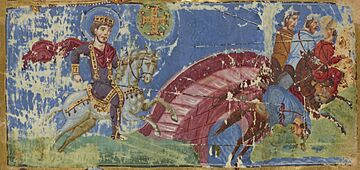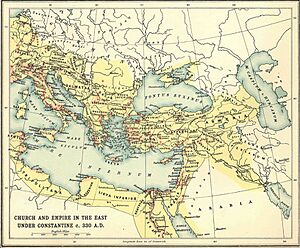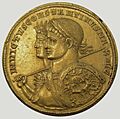Constantine the Great and Christianity facts for kids
During the rule of the Roman emperor Constantine the Great (306–337 AD), Christianity started to become the main religion of the Roman Empire. Historians are not sure why Constantine favored Christianity. They also debate which type of early Christianity he followed. Some think he became Christian because of his mother, Helena. Others say he encouraged her to convert to his faith.
Constantine ruled the Roman Empire as the only emperor for most of his time in power. Some experts believe he wanted everyone to accept his authority. So, he might have used Christianity to help his political goals. He may have thought it fit well with the imperial cult, which honored emperors.
No matter his exact reasons, Christianity grew a lot under Constantine's family, the Constantinian dynasty. This started the time of the state church of the Roman Empire. Historians still discuss if Constantine truly converted to Christianity or if he stayed loyal to paganism. Most historians agree he formally converted in 312. However, he was reportedly baptized only on his deathbed in 337. The real reasons for his conversion are still a mystery and debated.
Constantine's choice to stop the persecution of Christians in the Roman Empire was a huge moment for early Christianity. It's sometimes called the Triumph of the Church or the Peace of the Church. In 313, Constantine and Licinius made the Edict of Milan. This law made Christian worship legal. The emperor became a big supporter of the Church. He set an example for how a Christian emperor would work with the Church. He also helped develop ideas like orthodoxy (correct belief), Christendom (the Christian world), and church councils. The idea of a state church was later made official in 380. Constantine is seen as a saint in many Eastern Christian churches.
Contents
Before Constantine: Christians Face Challenges
The first official persecution of Christians by the Roman Empire happened in 64 AD. The Roman historian Tacitus wrote that Emperor Nero tried to blame Christians for the Great Fire of Rome. Church stories say that Peter and Paul were killed in Rome during Nero's rule.
Christians faced scattered and local persecutions for about 250 years. They refused to take part in the Roman imperial cult, which honored the emperor as a god. This was seen as treason, a crime punishable by death.
The biggest official persecution started in 303 under Emperor Diocletian. During this time, called the Great Persecution, Christian buildings and homes were torn down. Their holy books were collected and burned. Christians were arrested, tortured, and forced into gladiator fights for entertainment.
The Great Persecution officially ended in April 311. Galerius, a senior emperor, issued an edict of toleration. This law allowed Christians to practice their religion. However, it did not give back their property. Constantine and Licinius also signed this edict. Some believe Galerius changed his mind about persecuting Christians because of these two co-emperors.
Constantine's Conversion: A Turning Point
It's possible that Constantine's mother, Helena, introduced him to Christianity. He declared himself a Christian after issuing the Edict of Milan. Constantine wrote to Christians, saying he believed his successes were due to the protection of God.
The Battle of Milvian Bridge
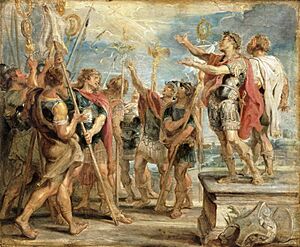
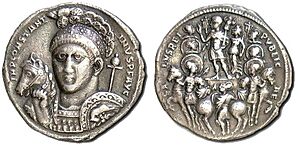
Christian writers like Eusebius of Caesarea say that Constantine had important experiences before the Battle of the Milvian Bridge on October 28, 312. This battle helped Constantine become the main emperor in the West.
According to Eusebius's Life of Constantine, Constantine saw a vision of "a cross-shaped trophy made of light" above the sun at midday. A message with it said, "By this conquer." This phrase is often translated into Latin as in hoc signo vinces.
Eusebius also wrote that Constantine had a dream that same night. In the dream, Christ appeared to him with the same sign. Christ told him to make a copy of the sign and use it for protection against enemies.
Another writer, Lactantius, wrote about Constantine's dream around 313–315. He said Constantine was told in a dream to mark a heavenly sign on his soldiers' shields. He did this by using a sideways letter X with its top bent around. This was a symbol for Christ.
It's not fully clear what Constantine saw or what was put on the shields. Eusebius's later writings suggest a more complex symbol. This symbol was the chi rho (☧). This is a monogram made from the first two Greek letters of "Christ" (Χ and Ρ).
After the battle, Constantine entered Rome. He did not make the usual sacrifices to the Roman gods. This was different from how generals usually celebrated victories. The Arch of Constantine, built to honor him, does not show him sacrificing to Jupiter. It does show him sacrificing to Apollo and Hercules.
Edict of Milan: Religious Freedom
In 313, Constantine and Licinius announced the Edict of Milan. This edict said that "Christians and all others should have liberty to follow that mode of religion which to each of them appeared best." This meant all religions, including Christianity, were tolerated.
The Edict of Milan went further than an earlier law from 311. It gave back property that had been taken from the Church. This edict made the empire officially neutral about religion. It did not make traditional religions illegal, nor did it make Christianity the state religion. That happened later in 380. However, the Edict of Milan did make Christianity more important in the empire.
Many powerful people in the empire, especially military leaders, were not Christian. They still followed traditional Roman religions. Constantine's rule showed he was willing to work with these groups. Coins made up to eight years after the battle still had images of Roman gods. The monuments he first ordered, like the Arch of Constantine, did not mention Christianity.
Constantine's Support for the Church

Constantine's rise to power was a turning point for early Christianity. After his victory, he became a strong supporter of the Christian faith. He gave money to the Church and had many basilicas (large churches) built. He also gave special benefits to clergy, like tax exemptions. He promoted Christians to important jobs. He returned property that was taken during the Great Persecution. He also gave the Church land and other riches.
Between 324 and 330, Constantine built a new city called New Rome at Byzantium. It was later named Constantinople after him. Unlike "old" Rome, this new city was built with Christian architecture. It had churches inside its walls and no old temples from other religions.
Constantine did require people who had not converted to Christianity to help pay for the new city. Christian writers say Constantine wanted to teach his people to give up their old religious practices. He wanted them to stop valuing their temples and statues. This led to temples closing because they lacked support. Their wealth then went to the emperor's treasury. Constantine did not need to use force for this.
Constantine respected educated people. His court included older, honored men. Leaders from important Roman families who did not convert to Christianity were not given top positions. However, they still received other appointments. Even near the end of his life, two-thirds of his top government officials were not Christian.
Constantine's laws showed his Christian beliefs. Crucifixion was stopped because of Christian values. However, it was replaced with hanging to show Roman power. On March 7, 321, Sunday was made an official day of rest. This day was holy to Christians for Christ's resurrection and to the Roman Sun God Sol Invictus. Markets were closed, and public offices were shut. However, farming work was allowed on Sundays.
Some laws made during his rule were very kind, even by today's standards. They supported tolerance, possibly inspired by his Christianity. For example, prisoners could no longer be kept in total darkness. They had to be given outdoor time and daylight. A condemned man could die in the arena, but his face could not be branded. This was because God was believed to have made humans in his image. Only their feet could be branded. Public gladiatorial games were ordered to be stopped in 325.
Church Construction
Constantine ordered the building of the first Church of Hagia Irene in Constantinople. This church celebrated the peace won by Constantine's victory over Licinius in 324. Its name, "Holy Peace," reminded people of the "Altar of Peace" built by Augustus.
Other large churches were dedicated to Saint Mocius and Saint Acacius. These saints were believed to have been killed in Byzantium during the Diocletianic Persecution. Christian services were also held in Constantine's Mausoleum, which later became the Church of the Holy Apostles.
Christian Emperorship: Defining Beliefs
Constantine's rule set a pattern for the role of a Christian emperor in the Church. Emperors believed they were responsible to God for the spiritual well-being of their people. After Constantine, they had a duty to help the Church define and keep correct beliefs. The Church usually thought that bishops should define beliefs. The emperor's job was to make sure these beliefs were followed, to stop heresy (incorrect beliefs), and to keep the Church united. The emperor made sure God was worshiped correctly in his empire. What "correct worship" meant was for the Church to decide.
Constantine became a worshiper of the Christian God. But he found that there were many different ideas about how to worship and even about who God was. In 316, Constantine was asked to help settle a dispute in North Africa. This was about the Donatist group, who refused to obey bishops who had given in to persecution.
More importantly, in 325, he called the First Council of Nicaea. This was the first major meeting of Christians to define correct beliefs for the entire empire. Before Nicaea, all church councils were local or regional.
Nicaea mainly dealt with the Arian controversy. This was a disagreement about whether Jesus was fully divine or created by God. Constantine was caught between the Arian and Trinitarian sides. After the Council of Nicaea, and against its decisions, he later brought Arius back from exile. He also sent Athanasius of Alexandria away.
Just before his death in May 337, it is said that Constantine was baptized as a Christian. He had been preparing for baptism for most of his adult life. He believed that if he waited until his deathbed, he would be less likely to sin and would go to heaven. He was baptized by his relative, the Arian Bishop Eusebius of Nicomedia. The Catholic Church and many Eastern Orthodox Churches believe he was baptized by Pope Sylvester I.
Stopping Other Religions
Constantine's views on the traditional Roman religions changed during his rule. Until 325, his coins and other official symbols connected him with the pagan cult of Sol Invictus (the Unconquered Sun). At first, Constantine encouraged building new temples and allowed traditional sacrifices. But by the end of his rule, he began to order the taking of wealth from and tearing down of Roman temples.
East of the Roman Empire, the Sasanian rulers, who were often at war with Rome, usually allowed Christianity. Constantine is said to have written to Shapur II in 324. He urged him to protect Christians in his kingdom. With Christianity becoming the state religion of the Roman Empire, Christians in Persia were seen as allies of Rome, Persia's old enemy.
The Constantinian Shift
Constantinian shift is a term used by some Christian thinkers and historians. It describes the political and religious changes that happened in the 4th century. This was when Constantine brought the imperial government and the Church closer together. This process began with the First Council of Nicaea. The term was made popular by the Mennonite theologian John H. Yoder. Some historians, like Peter Leithart, argue that there was only a "brief, unclear 'Constantinian moment'" and not a lasting "Constantinian shift."
Images for kids
See also
- Constantinianism
- Bishops of Rome under Constantine the Great
- Christian pacifism
- Labarum
- List of rulers who converted to Christianity
- Philip the Arab and Christianity


